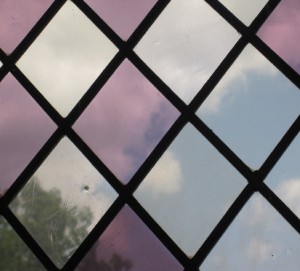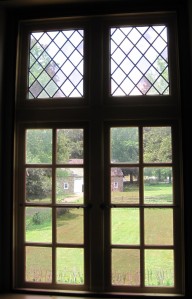This is a new section we are adding to the newsletter where we offer an exclusive look at pieces from Pennsbury Manor’s artifact collection! Look for additional features to be posted monthly.
Leaded Glass Windowpane

Description: Triangular-shaped glass with lead caning. Caning at the longest part of the triangle extends 5” beyond solder joint of caning to the edge of the glass. Several imperfections in the lead (small gaps between front and back pieces, dents). Glass tint is clear.
Before the discovery of this fragment of leaded glass and other types of window hardware in the archaeological excavation lead by Dr. Cadzow, the only information we had regarding the windows of the original Manor House came from William Penn’s letters. Any relevant information to be found in Penn’s letters was scattered and ambiguous, but the excavation of this window fragment unearthed a wealth of new and verifiable knowledge.
The physical measurements of the artifact were in accordance with the measurements mentioned in Penn’s letters, thereby elevating the known window dimensions from mere probable conjecture to a solidly proven fact, finally backed up by physical and documentary evidenc
From its materials, lead and glass, we could easily determine its origins, as it wasn’t until after 1739, when construction had already been completed for quite some time at Pennsbury, that any significant glass production took place in the Colonies. Therefore, we can be certain that this glass would have to have been imported from England and that the resulting increase in price also resulted in the increase of its value. Not only was glass expensive, the added cost of importing from England was increased by heavy taxation.

by Rebecca Remmey
For further reading, check out these sources:
Cadzow, Donald. “Excavations at Pennsbury.” Report to The Historic Commission, 1934.
Phillips, Steven J. Old-House Dictionary: An Illustrated Guide to American Domestic Architecture (1600-1940). Lakewood: American Source Books, 1989.
Tidlow, Evelyn M., Frederick L. Walters, Patrick W. O’Bannon, and Kenneth Jacobs. Historic Structures Report for Pennsbury Manor Morrisville, Pennsylvania. Eds. John P. McCarthy and Daniel G. Roberts. West Chester: John Milner Associates, Inc., 1987.
Tunis, Edwin. Colonial Living. New York: Thomas Y. Crowell Company, 1957.
Weener, Carol G. “Pennsbury Manor: A Study in Colonial Revival Preservation, Historic Preservation.” Thesis, University of Pennsylvania, 1986.
